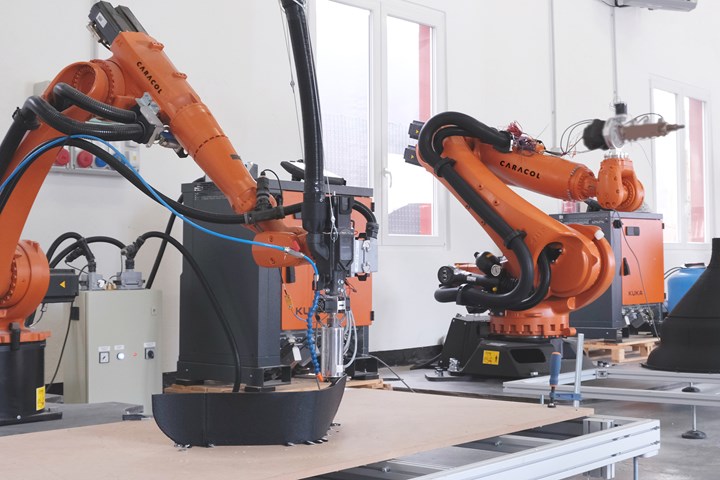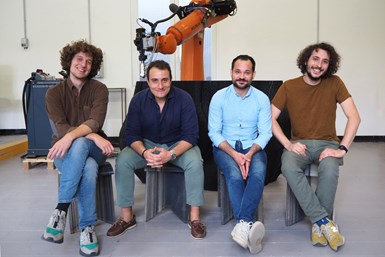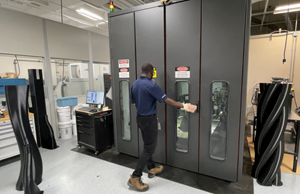
The Caracol process includes a large-scale, robot-mounted, extrusion-based 3D printer compatible with a variety of materials including up to 40% fiber-filled polymers. Photo credit, all images: Caracol
Caracol (Lomazzo, Italy) is a startup large-scale additive manufacturing (AM) specialist founded in 2017 with the goal of scaling up 3D printing for high-performance industrial applications. “Our mission is to work on increasingly extreme and advanced applications, in advanced sectors such as aerospace and automotive. We believe that large scale is the key to push additive manufacturing as a technology, way beyond what is possible today,” explains Violetta Nespolo, chief marketing and strategy officer at Caracol.

One focus area for Caracol is composite aerospace tooling. This large-scale tooling jig, used to manufacture belly fairing panels of an aircraft, measured 84.8 cm wide x 125 cm long x 37.5 cm high, printed in one piece from carbon fiber/PA.
She adds, “We started by working with existing printers, and seeing what we could do to expand the scale of what was possible. We found robotic arms give the maximum flexibility to print large, complex parts.”
After its initial research phase, Caracol ultimately developed and patented an extrusion-based 3D printing system, including design and print management software, to mount on Kuka robotic arms. Currently, the system can print parts up to four meters wide — though Nespolo says it could print up to 10 meters wide with the addition of a trolley or rail system if needed.

This automotive rear wing for a luxury automotive OEM was built from carbon fiber/PA12 via a combination of a 3D-printed composite internal liner with an additional layer of carbon fiber laminated over top for increased performance. Caracol reports a weight savings of 33% compared to the previous materials and process used, overall cost savings of 50% and a reduction in production time from six weeks to five days.
The system is compatible with a range of polymers such as polyamide (PA), polyphenylene sulfide (PPS) and polypropylene (PP), unreinforced or reinforced with up to 40% carbon or glass fiber. “We’re able to use a very broad range of materials beyond traditional 3D printing filaments, including the same type of pellets used in injection molding, which allows us to use composites with a higher percentage of fiber compared to traditional 3D printing filaments,” Nespolo says.
Today, Caracol offers clients a full range of design, engineering, prototyping and short- or medium-series production runs at its Italy facility. In addition to its patented large-scale system, the company also has capabilities for printing with FDM and SLA printers of various sizes.

The founding team at Caracol, pictured left to right: Giovanni Avallone, chief design and engineering officer; Francesco De Stefano, CEO; Jacopo Gervasini, CFO; and Paolo Cassis, COO.
The company produces a variety of prototype parts for automotive and other industries, but one of its main focuses currently is large-scale aerospace tooling, Nespolo says. For example, Caracol recently built a large-scale, additively manufactured tool for airplane belly fairings panels, printed in a single piece and then CNC machined to achieve the part’s required dimensional tolerances of 0.1 miliimeters and surface roughness of 1.6 μm. Caracol’s process reduced the number of pieces from more than 30 to one, cut the production time from six weeks to five days and saved the customer 35% in overall costs. “We’re working on finding solutions that really go beyond the traditional way of doing things,” Nespolo says. “The product can be customized and produced extremely quickly and cost-effectively compared to traditional metal tooling solutions.”
Future developments include structural automotive and aerospace part production, even larger print volumes, the addition of CNC milling for integrated part finishing and compatibility with higher-performance materials such as polyetheretherketone (PEEK), polyaryletherketone (PAEK) and continuous fiber reinforcement.
Related Content
The AAMMC Tech Hub: Ramping U.S. production of large thermoplastic composite aerostructures
CW talks with Syensqo, Spirit AeroSystems and other consortia members about current funding, specification of the next world’s largest press, organizational structure and projects to support U.S. companies in the race to deliver >40,000 sustainable and efficient aircraft over the next 20 years.
Read MoreUpdate: THOR project for industrialized, recyclable thermoplastic composite tanks for hydrogen storage
A look into the tape/liner materials, LATW/recycling processes, design software and new equipment toward commercialization of Type 4.5 tanks.
Read MoreEaton developing carbon-reinforced PEKK to replace aluminum in aircraft air ducts
3D printable material will meet ESD, flammability and other requirements to allow for flexible manufacturing of ducts, without tooling needed today.
Read MoreDevelopment of a composite liquid hydrogen tank for commercial aircraft
Netherlands consortium advances cryogenic composites testing, tank designs and manufacturing including AFP, hybrid winding, welding of tank components and integrated SHM and H2 sensors for demonstrators in 2025.
Read MoreRead Next
Ceramic matrix composites: Faster, cheaper, higher temperature
New players proliferate, increasing CMC materials and manufacturing capacity, novel processes and automation to meet demand for higher part volumes and performance.
Read MoreUltrasonic welding for in-space manufacturing of CFRTP
Agile Ultrasonics and NASA trial robotic-compatible carbon fiber-reinforced thermoplastic ultrasonic welding technology for space structures.
Read MoreScaling up, optimizing the flax fiber composite camper
Greenlander’s Sherpa RV cab, which is largely constructed from flax fiber/bio-epoxy sandwich panels, nears commercial production readiness and next-generation scale-up.
Read More

.jpg;width=70;height=70;mode=crop)





















